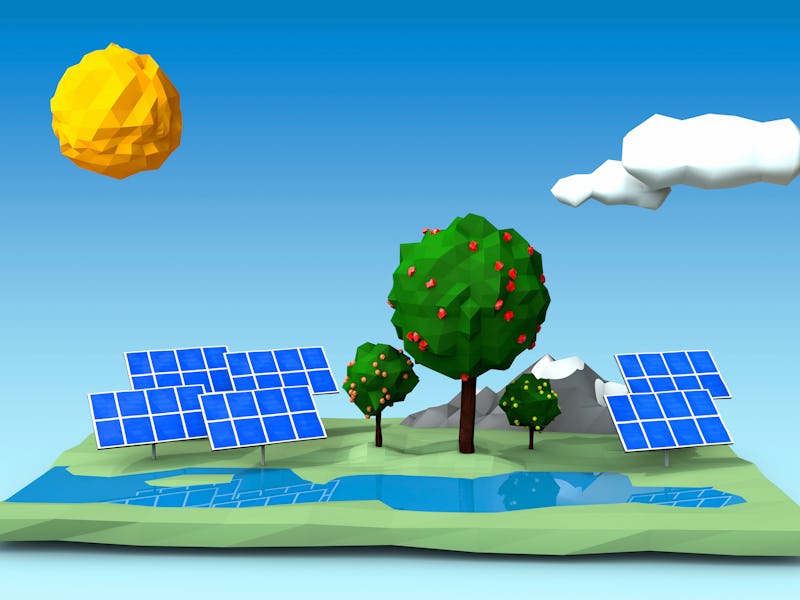The Green New Deal needs batteries. Nanomaterials might be the solution.
The biggest change in energy might start incredibly small.

One of the main challenges when it comes to replacing fossil fuels with renewable energy is storing that energy so it can be used when energy is not currently being generated. As President Trump so eloquently once put it, the wind “only blows sometimes.”
“Turn off the television darling, please. There’s no wind, please turn off the television quickly,” Trump said in March, seemingly imitating a problem you might encounter if you rely on wind energy.
The sun is also only out sometimes, which means solar panels are only generating energy sometimes. At times of the day when demand for energy is low, we need to be able to store excess energy. At times of the day when demand for energy is high, we need to have energy stored to meet demand.
We’ve come a long way when it comes to battery technology, but improvements need to be made. As the MIT Technology review reported last year, lithium-ion storage systems are currently “too expensive and don’t last nearly long enough.” This kind of storage system needs to be constantly being improved on, and one way we’re doing that is by integrating nanomaterials into these power storage systems.
According to a new report that was just published in the journal Science, we’ll need to double down on integrating nanomaterials into power storage systems to get where we need to go.
Yury Gogotsi, an engineering professor at Drexel and author of the report, tells Inverse that nanomaterials will help us overcome the challenges we’re currently facing.
“We need to change the way we build our storage devices-how we assemble batteries,” Gogotsi says.
Gogotsi says we’ve already started using nanomaterials, such as carbon nanotubes and nano-silicon particles, in things like laptop and phone batteries to make them charge faster and increase how much energy can be stored. Nanomaterials can speed up the flow of electrons in a battery because of their high electronic conductivity, shape and atomic structure, and the increased surface area allows more ions to be stored on the surface, increasing the charging rate.
“The idea is to store more energy, do it faster and deliver it faster,” Gogotsi says. “This is exactly the type of thing nanomaterials can potentially do.”
By switching to nanomaterials, we can eliminate the metal foil current collectors often found in batteries. This means batteries will be able to charge and discharge faster, hold more power, they will be lighter and the components will take up less space.
See also: With Tesla Megapack, Elon Musk Is Quietly Shifting Hard Toward Clean Energy
People think nanomaterials are expensive, Gogotsi says, but that’s no longer the case. He says there are facilities in China that produce 300 tons of carbon nanotubes per year for affordable prices. As the market grows, too, the prices will go down.
We may also begin to move away from the lithium-ion battery, Gogotsi says. He thinks it will remain a commonly-used battery for quite some time, but he says starting to utilize more lithium-sulfur batteries and zinc-ion batteries could lower costs and help alleviate energy storage issues.
Gogotsi foresees a future where renewable energy has been decentralized, and there are solar panels and other energy generators all over the place. With the right storage technology, we could seamlessly transfer energy to storage systems from many different origin points. He thinks this will make it so large energy generators don’t have to send energy across long distances, which means losing energy along the way.
“We should be able to generate a lot of energy locally, in many different places, and then we won’t have to send that much energy very far away, “ Gogotsi says. “I think this is one of the key advantages energy storage can bring.”
Abstract:
Lithium-ion batteries, which power portable electronics, electric vehicles, and stationary storage, have been recognized with the 2019 Nobel Prize in chemistry. The development of nanomaterials and their related processing into electrodes and devices can improve the performance and/or development of the existing energy storage systems. We provide a perspective on recent progress in the application of nanomaterials in energy storage devices, such as supercapacitors and batteries. The versatility of nanomaterials can lead to power sources for portable, flexible, foldable, and distributable electronics; electric transportation; and grid-scale storage, as well as integration in living environments and biomedical systems. To overcome limitations of nanomaterials related to high reactivity and chemical instability caused by their high surface area, nanoparticles with different functionalities should be combined in smart architectures on nano- and microscales. The integration of nanomaterials into functional architectures and devices requires the development of advanced manufacturing approaches. We discuss successful strategies and outline a roadmap for the exploitation of nanomaterials for enabling future energy storage applications, such as powering distributed sensor networks and flexible and wearable electronics.